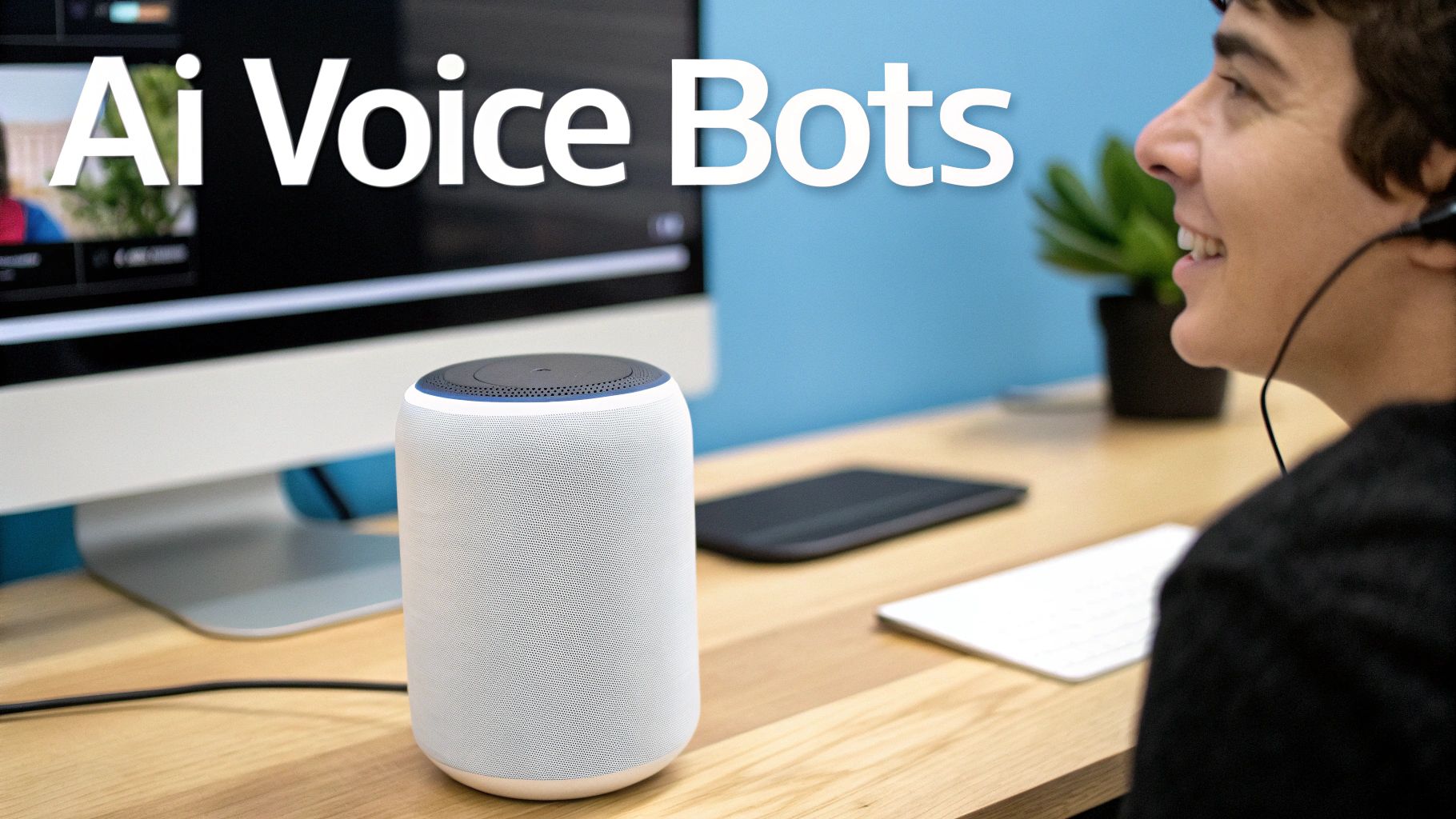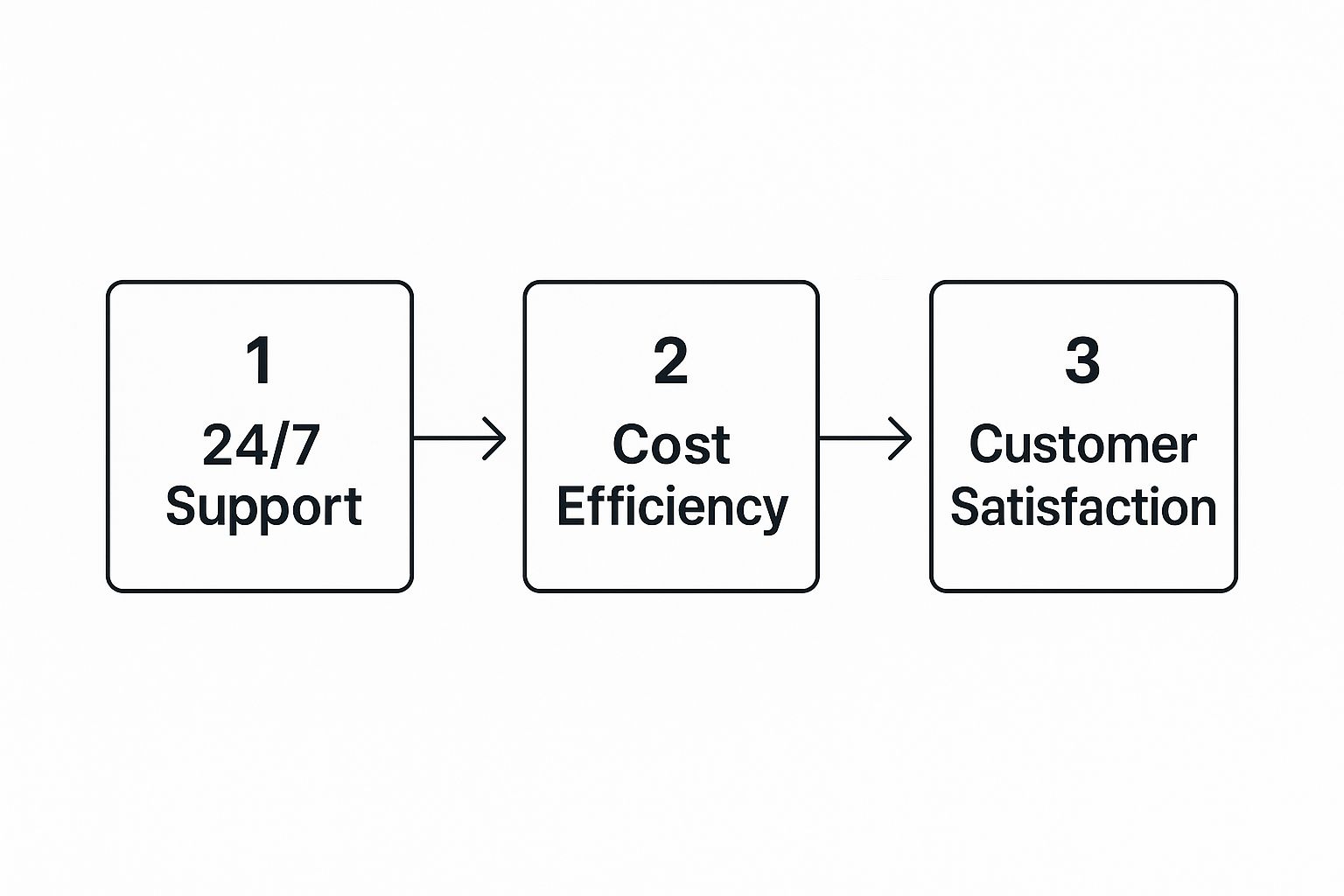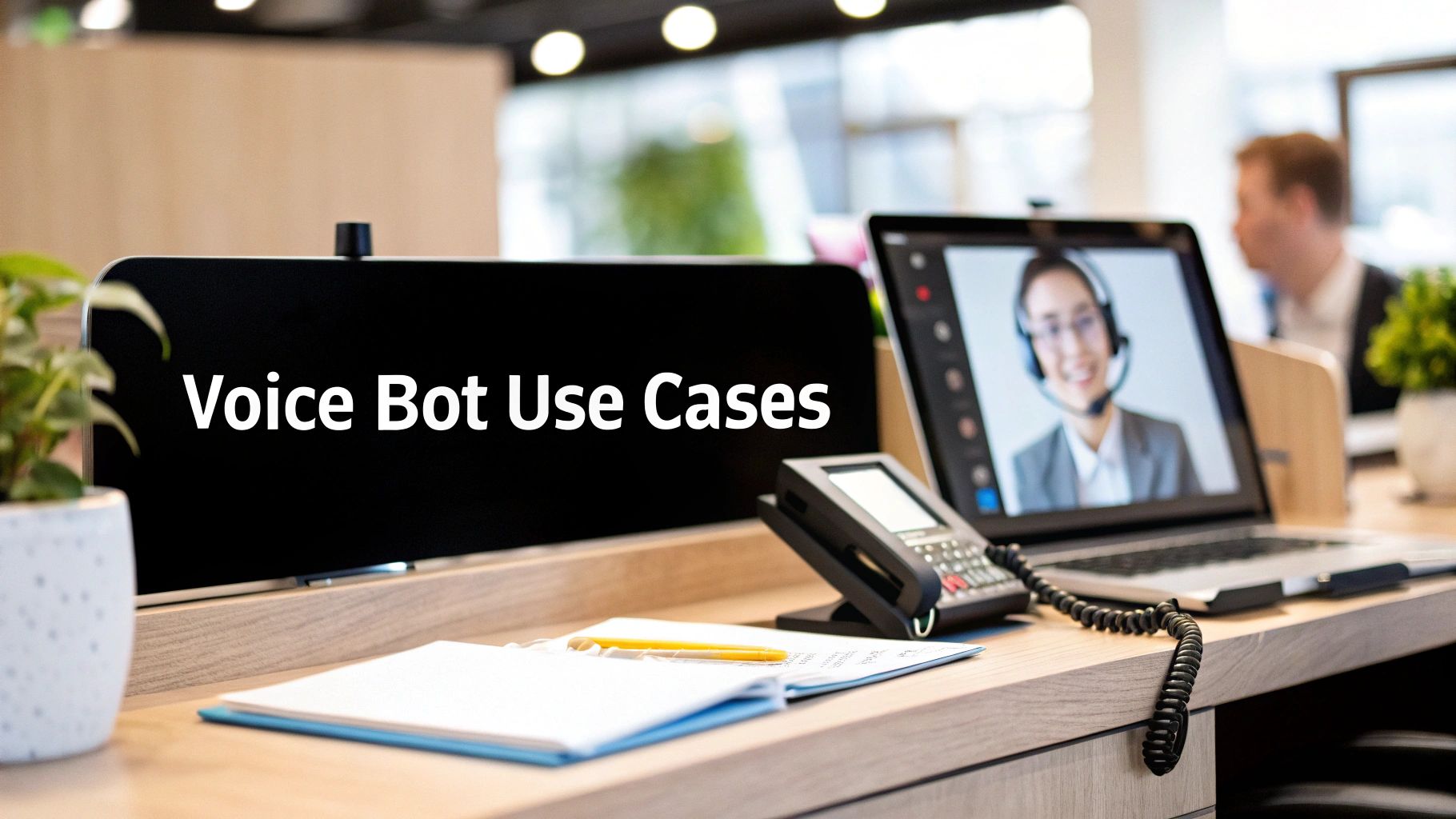An AI voice bot is essentially an automated software program built to have natural, spoken conversations with people over the phone. Think of it as a hyper-efficient digital team member that works around the clock to handle calls, answer questions, and even book appointments—all without ever needing a coffee break.

Picture a front desk that never misses a call, can chat fluently in multiple languages, and instantly resolves the most common customer questions. That's the real power of an AI voice bot. It's so much more than a pre-recorded message; it's an intelligent conversational partner designed to understand and respond to human speech in real-time.
This kind of technology isn't just for sci-fi movies or giant corporations anymore. Thanks to voice assistants like Alexa and Google Assistant becoming part of our daily lives, people are now completely comfortable talking to technology. This cultural shift has set the stage perfectly for businesses—especially small businesses—to bring these same powerful tools into their own operations.
We're gradually moving away from a world dominated by screens and keyboards and into a voice-first era. More and more, customers prefer the simple speed and convenience of speaking over typing. An AI voice bot meets this demand head-on by offering an immediate, direct, and natural line of communication.
By taking over the routine and repetitive calls, AI voice bots free up your human staff to focus on more complex, high-value tasks that truly require empathy and critical thinking. The result is a more efficient and productive workplace.
This technology is fundamentally changing how companies connect with their customers. It opens the door to better operational efficiency, lower costs, and a serious competitive advantage. To get a deeper look at this trend, you can explore the future of voice AI agents and see how they're reshaping communication.
So, what's making these bots so compelling for businesses right now? The advantages stretch far beyond just answering the phone.
When businesses embrace this technology, they aren't just keeping up with the times. They're building a more resilient, customer-focused operation that's ready for whatever comes next. This guide will walk you through exactly how to put this powerful tool to work for your own business.
Ever wondered how a machine can grasp the subtle nuances in your voice—not just what you say, but how you say it? It’s not magic. It’s a sophisticated, three-part process working in perfect sync to make a conversation feel fluid and natural. This system is what allows AI voice bots to be intelligent partners rather than just robotic command-takers.
Think of it like a perfectly coordinated team handling a customer call. Each member has a specific role, and they execute it instantly to keep the conversation moving forward without a hitch.
First things first, the AI has to "hear" you. That’s the job of Automatic Speech Recognition (ASR) technology. ASR acts as the ears of the operation, with the sole purpose of capturing the sound waves of your voice and converting them into written text.
This is the critical foundation. If the transcription isn’t accurate, everything that follows will be built on flawed information, leading to confusion and a frustrating experience. This is where advanced tools like Deepgram's speech-to-text technology come in, engineered to turn spoken words into clean, processable text with incredible precision.
Once your words are on the page, the AI is ready for the next, more complex step: figuring out what you actually mean.
With the text in hand, the AI moves on to the analysis phase, which is handled by Natural Language Processing (NLP). This is the "brain" of the voice bot. NLP doesn't just read words; it digs deeper to analyze grammar, context, and the relationships between words to figure out the speaker's intent.
For instance, NLP can tell the difference between "I need to book a flight" and "I want to read a book." It understands one is a request for an action, while the other refers to an object.
This is where the real intelligence of AI voice bots shines. They can pick out key details like dates, names, or order numbers and even get a read on the caller's mood through sentiment analysis. This cognitive engine is what allows the bot to have a truly meaningful and productive conversation. The voice AI agent market is seeing massive investment, projected to explode from $2.4 billion in 2024 to $47.5 billion by 2034. This growth is fueled by its powerful applications in customer service, healthcare, and beyond.
After the AI understands the request and figures out the right response, the final step is to talk back. This is where Text-to-Speech (TTS) technology comes in. TTS is the "mouth" of the bot, converting the AI's text-based answer into natural-sounding, human-like speech.
Modern TTS systems are incredibly advanced. They can replicate human intonation, pauses, and emphasis, making the interaction feel less robotic and more like a conversation with a real person. This creates a much more engaging and pleasant experience for the caller.
The quality of the TTS voice is crucial. A clear, warm, and natural voice builds trust and keeps customers engaged, bringing the conversational loop to a satisfying close.
This infographic shows how these three elements work together to drive real business results.

Ultimately, this seamless process leads from 24/7 support and cost savings directly to higher customer satisfaction.

Let's be honest—not all AI voice bots are created equal. While the basic technology is impressive on its own, the specific features you choose will make or break the value it brings to your business. It's like equipping a new team member; giving them the right tools is what separates someone who just answers the phone from a true game-changer.
To see a real return on your investment, you need to look past a simple automated answering machine. A truly high-performing bot acts as an intelligent extension of your team, capable of handling complex situations and genuinely improving the customer experience.
Let’s dig into the mission-critical features that actually deliver on that promise.
Certain features are the absolute bedrock of a good voice bot. Think of these as the non-negotiables—the foundational tools that allow your business to see immediate improvements in efficiency and customer service.
These foundational features ensure your AI voice bot handles the basics flawlessly, providing immediate, tangible value from day one.
Once the basics are covered, it's the advanced capabilities that unlock a bot's true potential. These are the features designed to manage more nuanced interactions and provide deeper business insights, setting the best AI voice bots apart from the pack.
A key differentiator is sentiment analysis. Think of this as the bot’s emotional intelligence. It listens to a caller's tone of voice, word choice, and even their pacing to figure out if they’re happy, frustrated, or just neutral.
By understanding a customer's emotional state, the AI voice bot can adapt its approach in real-time. If it detects frustration, it can adjust its language to be more empathetic or quickly escalate the call to a human agent for specialized care.
This single capability transforms a standard, robotic interaction into a more human-like and responsive experience, which is absolutely crucial for building customer loyalty. The entire market for AI chatbots and voice agents is seeing explosive growth for a reason. Projections estimate the market will be worth between $10 billion and $15 billion in 2025, with some forecasts reaching as high as $47 billion by 2029. These AI agents are already handling up to 80% of routine inquiries for many businesses, leading to huge efficiency gains.
Another game-changing feature is the ability to connect with your other software through APIs. This allows your voice bot to perform actions during the call. It could check a live inventory database, process a payment through a secure gateway, or schedule an appointment directly in your Google Calendar—all while talking to the customer.
Exploring the full list of available AI Front Desk features can show you just how powerful a deeply integrated system can be.
Ultimately, the right mix of core and advanced features creates a tool that doesn't just answer calls, but actively helps grow your business.
Of course. Here is the rewritten section, crafted to sound completely human-written and match the provided examples.
Theory is one thing, but seeing AI voice bots in the wild is where it all really clicks. So how are actual businesses—from bustling online stores to busy healthcare clinics—using this tech to get ahead? The applications are surprisingly practical and deliver results you can see and measure.
These bots are far from being some futuristic novelty; they're frontline tools solving real, everyday business headaches. They handle the repetitive stuff, make customer chats better, and create genuine savings. Let's look at a few before-and-after scenarios to see the kind of impact they’re making.
One of the biggest wins for AI is in customer service, especially with the rise of AI chatbots for customer support in ecommerce.
Before: Imagine a mid-sized online clothing store drowning in "Where is my order?" calls. Their small support team spent nearly all day just looking up tracking numbers. This left almost no time for tricky issues, handling returns, or helping people with new purchases. Wait times were long, and customers were getting annoyed.
After: By bringing in an AI voice bot, the company automated 80% of its order status questions. The bot, hooked up to their shipping software, could instantly give callers real-time tracking info. This one change freed up their human agents to focus on conversations that actually make money—like upselling or solving unique problems—leading to a noticeable jump in both sales and happiness.
This kind of smart automation is a huge reason the global voice AI market is exploding. It's expected to rocket from about $6.8 billion in 2024 to $32.6 billion by 2033. This growth is fueled by how comfortable we've all become with voice assistants, now found on over 8.4 billion devices, and our willingness to use our voice for tasks like shopping.
In healthcare, efficiency and accuracy aren't just nice-to-haves; they're critical. A single missed appointment can throw off a whole day's schedule and affect patient care.
Before: A busy dental practice had a front-desk employee manually calling hundreds of patients every week just to confirm appointments. It was a huge time-sink and, being a manual task, was prone to mistakes. The result? A consistent no-show rate of around 15%, which meant empty chairs and a big hit to revenue.
After: The practice set up an AI voice bot to handle all appointment confirmations and reminders. The bot would call patients two days ahead of time, offer to reschedule by connecting directly to the clinic's calendar, and even send a follow-up text. This simple switch dropped their no-show rate to under 5%. That's thousands of dollars saved every month and a much more predictable, fully booked schedule.
The magic of AI voice bots isn't just for customers. They're also fantastic at smoothing out internal jobs for departments like IT and HR.
Think about these common internal headaches:
By taking over these predictable, repeatable tasks, AI voice bots let your specialized teams focus their brainpower on the strategic work that actually pushes the business forward. As these real-world examples show, the only limit is your company's own needs and a little bit of creativity.

Jumping into new technology can feel like a massive undertaking, but setting up an AI voice bot doesn't have to be a headache. With a clear plan, you can smoothly introduce this powerful tool into your daily operations. The real secret? Start small and focus on delivering a quick, tangible win.
This isn't about overhauling your entire business overnight. It's about strategically picking one specific problem and solving it exceptionally well with automation. This blueprint will walk you through the essential steps, from your first idea to a fully functioning bot that makes a real difference.
Before you even touch any technology, think about your biggest pain points. What repetitive, high-volume task is currently eating up your team's valuable time? That’s your perfect starting point.
Don't try to build a bot that does everything at once. Focus on a simple, high-impact goal that provides immediate relief. Good places to start often include:
Choosing one of these tasks ensures you can measure success quickly and prove the value of your AI voice bot right out of the gate. This builds momentum and gives you the confidence to tackle more complex projects down the road.
Once you know what you want to automate, the next step is figuring out how you'll build it. Your technology partner is a critical piece of the puzzle, and you should look for a solution that can grow with you.
Keep these key factors in mind when looking at different platforms:
It’s also smart to look at the provider’s pricing structure. Transparent plans help you find a solution that fits your budget without any surprise fees. Exploring the pricing for My AI Front Desk can give you a clear idea of how different features and capabilities line up with what your business actually needs.
A successful integration is less about finding the most advanced technology and more about finding the right-fit solution. The goal is to get a tool that solves your specific problem effectively without adding unnecessary complexity to your workflow.
AI voice bots are a core component of digital transformation, acting as a foundational technology for automating different parts of the sales cycle. To understand how to best use them, it's worth exploring strategies for mastering sales process automation.
With a use case picked and a platform chosen, the final phase is bringing your bot to life. This involves designing the conversation, testing its performance, and committing to ongoing improvements. It’s a cycle, not a one-and-done task.
1. Design the Conversation: Start by mapping out the ideal call flow. What questions will the bot ask? What are the likely customer responses? Keep the language natural, simple, and friendly to create a great experience from the start.
2. Train with Your Data: The best AI voice bots are trained on real-world examples. Use recordings of past calls or common questions from emails to help the AI understand your customers' unique phrasing and vocabulary.
3. Test Rigorously: Before you go live, conduct internal tests. Have your team call the bot and try to "break" it by asking unexpected questions or using slang. This is how you find and fix weak spots in the conversation flow before your customers do.
4. Launch and Monitor: Once you're feeling confident, launch your bot. But the work doesn't stop there. Listen to call recordings and review the analytics to see how it’s performing in the wild. Use these insights to continuously tweak its responses and improve its effectiveness over time.
Bringing an AI voice bot into your business isn't just a simple tech update. It’s a real strategic decision that gets you ready for what’s coming next. The move toward voice-first conversations isn't some passing fad; it's a fundamental shift in how people want to connect with companies. By getting on board now, you're building a business that's more resilient, efficient, and truly centered around your customers.
The benefits are hard to ignore. We're talking about offering incredible 24/7 customer service, seriously cutting down on operational costs, and pulling powerful insights from every single phone call. Each one of these perks feeds directly into a healthier bottom line and gives you a stronger footing in your market.
The most important thing? Just start. You don’t need to plan a massive, company-wide project right out of the gate. The smartest way to begin is to start small and prove it works.
Pick one high-volume, low-complexity problem to tackle first. A pilot project to automate appointment scheduling or answer common FAQs can show immediate, tangible results. This builds momentum and makes it easier to get everyone on board for more.
That first win proves the value of AI voice bots and gives you a solid foundation to expand from. By adopting voice technology early, you’re setting your business up to lead the pack in a world that’s becoming more automated and conversational by the day.
The future of customer service is already here, and a voice AI bot is your ticket in. For small businesses trying to keep up with the big players, this technology is a game-changer. It evens the playing field, letting you offer the same kind of instant, professional support they do. You can see a deeper breakdown of how a voice AI bot is revolutionizing customer service.
By adopting these tools today, you're not just putting out fires—you're investing in a serious competitive edge that will pay off for years to come, making sure your business doesn't just survive, but thrives.
Of course. Here is the rewritten section, crafted to sound completely human-written and natural, following the provided style guide and examples.
Even when you see the potential of AI voice bots, it's natural to have some practical questions. Before bringing any new tool into your business, you need to be sure about the cost, what it can realistically do, and how it handles security. Let's tackle the most common questions we hear so you can feel confident moving forward.
The price tag for an AI voice bot can really vary, and it all comes down to what you need it to do. For a straightforward bot that uses a template to answer basic FAQs, you might find subscription services starting at a few hundred dollars a month. That’s a fantastic starting point for many small businesses.
If you're looking for a completely custom-built bot that ties deep into your CRM and can handle more advanced conversations, you’re looking at a more significant investment. The trick is to match the bot's complexity (and cost) with the real business value it’s going to deliver. My advice? Always start with a use case that gives you a high return to prove its worth.
Let's be clear: the real magic of AI voice bots is their ability to flawlessly handle high-volume, predictable tasks. Think order tracking, appointment scheduling, or answering the same questions over and over. This is what frees up your human experts to step in for the complex, high-empathy situations that truly need a personal touch.
The best strategy is almost always a hybrid approach. Let the bot act as the first line of defense, gathering info and resolving simple issues. When a problem gets tricky or a caller gets upset, the bot can smoothly hand off the call—along with all the context it has already gathered—to a human agent.
This way, callers get instant, efficient help for routine stuff and expert attention when it matters most. It’s the best of both worlds.
We've come a long way from the choppy, robotic voices of the past. Modern Text-to-Speech (TTS) technology has made some incredible leaps. Today’s bots use advanced AI to speak with realistic pacing, tone, and intonation, making conversations feel much more engaging and less like talking to a machine.
Many platforms let you pick from a library of high-quality voices. You can even create a custom branded voice that perfectly matches your company’s personality. This helps ensure every call delivers a consistent, pleasant experience that reinforces who you are as a brand.
For any business, security is non-negotiable. Period. Any reputable AI voice bot provider must follow strict data protection rules like GDPR and be ready to handle payments securely under PCI DSS guidelines.
All conversations should be protected with end-to-end encryption to block anyone from snooping. And when it comes to truly sensitive information like credit card numbers, the system has to use secure methods to redact that data. This ensures it’s never stored or exposed, protecting both your customers and your business from risk.
Ready to see how an AI voice bot can transform your lead conversion and customer service? My AI Front Desk offers a powerful, easy-to-use solution designed for small businesses. Stop missing calls and start making more revenue.
Start your free trial for My AI Front Desk today, it takes minutes to setup!








